FIAT DUCATO BASE CAMPER 2015 Owner handbook (in English)
Manufacturer: FIAT, Model Year: 2015, Model line: DUCATO BASE CAMPER, Model: FIAT DUCATO BASE CAMPER 2015Pages: 367, PDF Size: 19.73 MB
Page 191 of 367
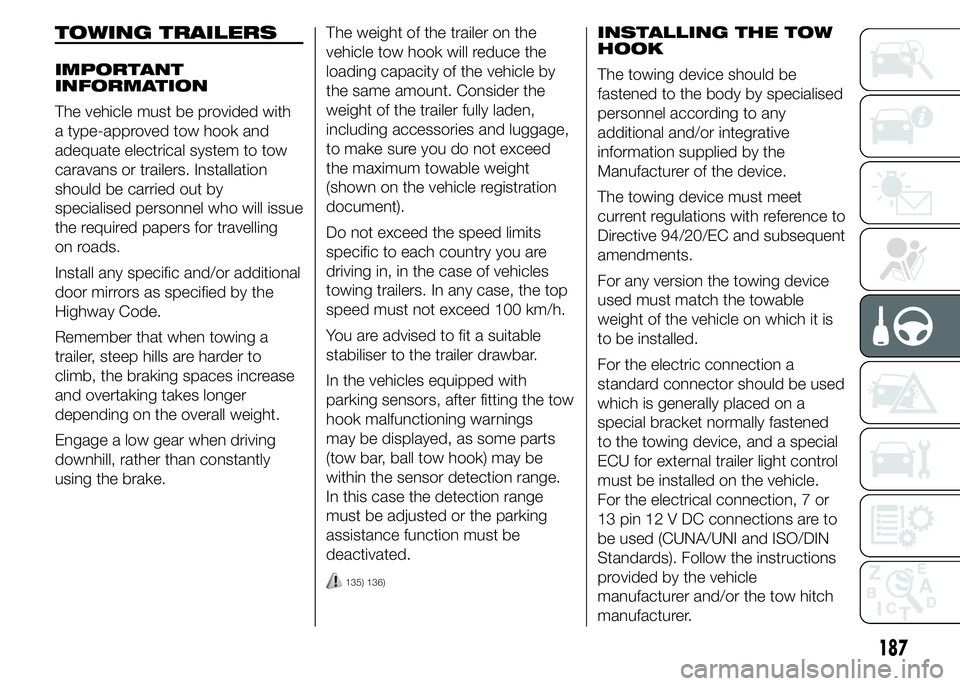
TOWING TRAILERS
IMPORTANT
INFORMATION
The vehicle must be provided with
a type-approved tow hook and
adequate electrical system to tow
caravans or trailers. Installation
should be carried out by
specialised personnel who will issue
the required papers for travelling
on roads.
Install any specific and/or additional
door mirrors as specified by the
Highway Code.
Remember that when towing a
trailer, steep hills are harder to
climb, the braking spaces increase
and overtaking takes longer
depending on the overall weight.
Engage a low gear when driving
downhill, rather than constantly
using the brake.The weight of the trailer on the
vehicle tow hook will reduce the
loading capacity of the vehicle by
the same amount. Consider the
weight of the trailer fully laden,
including accessories and luggage,
to make sure you do not exceed
the maximum towable weight
(shown on the vehicle registration
document).
Do not exceed the speed limits
specific to each country you are
driving in, in the case of vehicles
towing trailers. In any case, the top
speed must not exceed 100 km/h.
You are advised to fit a suitable
stabiliser to the trailer drawbar.
In the vehicles equipped with
parking sensors, after fitting the tow
hook malfunctioning warnings
may be displayed, as some parts
(tow bar, ball tow hook) may be
within the sensor detection range.
In this case the detection range
must be adjusted or the parking
assistance function must be
deactivated.
135) 136)
INSTALLING THE TOW
HOOK
The towing device should be
fastened to the body by specialised
personnel according to any
additional and/or integrative
information supplied by the
Manufacturer of the device.
The towing device must meet
current regulations with reference to
Directive 94/20/EC and subsequent
amendments.
For any version the towing device
used must match the towable
weight of the vehicle on which it is
to be installed.
For the electric connection a
standard connector should be used
which is generally placed on a
special bracket normally fastened
to the towing device, and a special
ECU for external trailer light control
must be installed on the vehicle.
For the electrical connection, 7 or
13 pin 12 V DC connections are to
be used (CUNA/UNI and ISO/DIN
Standards). Follow the instructions
provided by the vehicle
manufacturer and/or the tow hitch
manufacturer.
187
Page 192 of 367
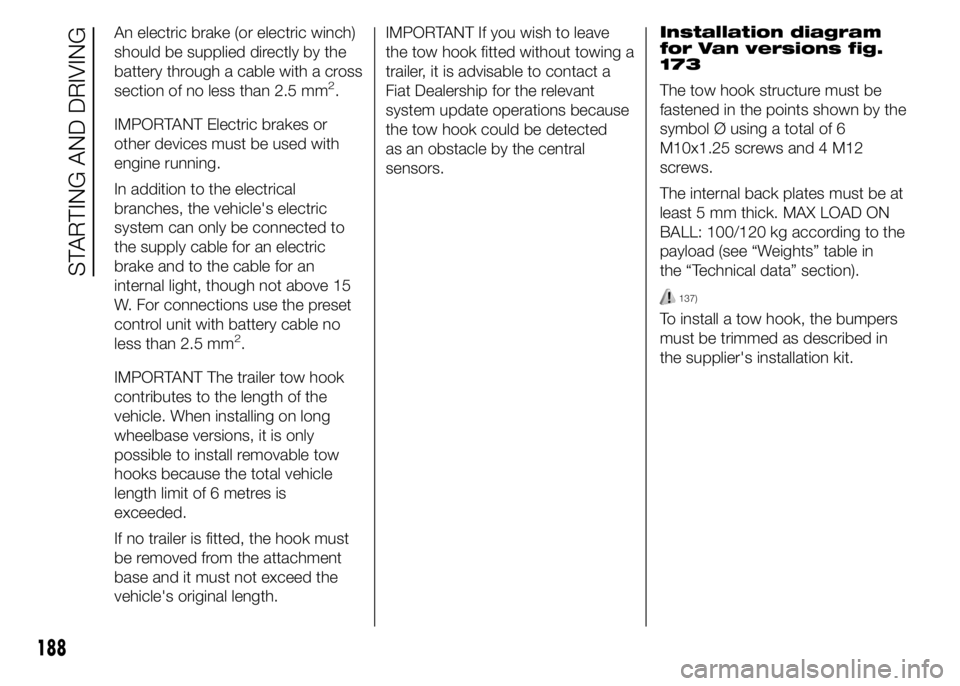
An electric brake (or electric winch)
should be supplied directly by the
battery through a cable with a cross
section of no less than 2.5 mm
2.
IMPORTANT Electric brakes or
other devices must be used with
engine running.
In addition to the electrical
branches, the vehicle's electric
system can only be connected to
the supply cable for an electric
brake and to the cable for an
internal light, though not above 15
W. For connections use the preset
control unit with battery cable no
less than 2.5 mm
2.
IMPORTANT The trailer tow hook
contributes to the length of the
vehicle. When installing on long
wheelbase versions, it is only
possible to install removable tow
hooks because the total vehicle
length limit of 6 metres is
exceeded.
If no trailer is fitted, the hook must
be removed from the attachment
base and it must not exceed the
vehicle's original length.IMPORTANT If you wish to leave
the tow hook fitted without towing a
trailer, it is advisable to contact a
Fiat Dealership for the relevant
system update operations because
the tow hook could be detected
as an obstacle by the central
sensors.Installation diagram
for Van versions fig.
173
The tow hook structure must be
fastened in the points shown by the
symbol Ø using a total of 6
M10x1.25 screws and 4 M12
screws.
The internal back plates must be at
least 5 mm thick. MAX LOAD ON
BALL: 100/120 kg according to the
payload (see “Weights” table in
the “Technical data” section).
137)
To install a tow hook, the bumpers
must be trimmed as described in
the supplier's installation kit.
188
STARTING AND DRIVING
Page 193 of 367
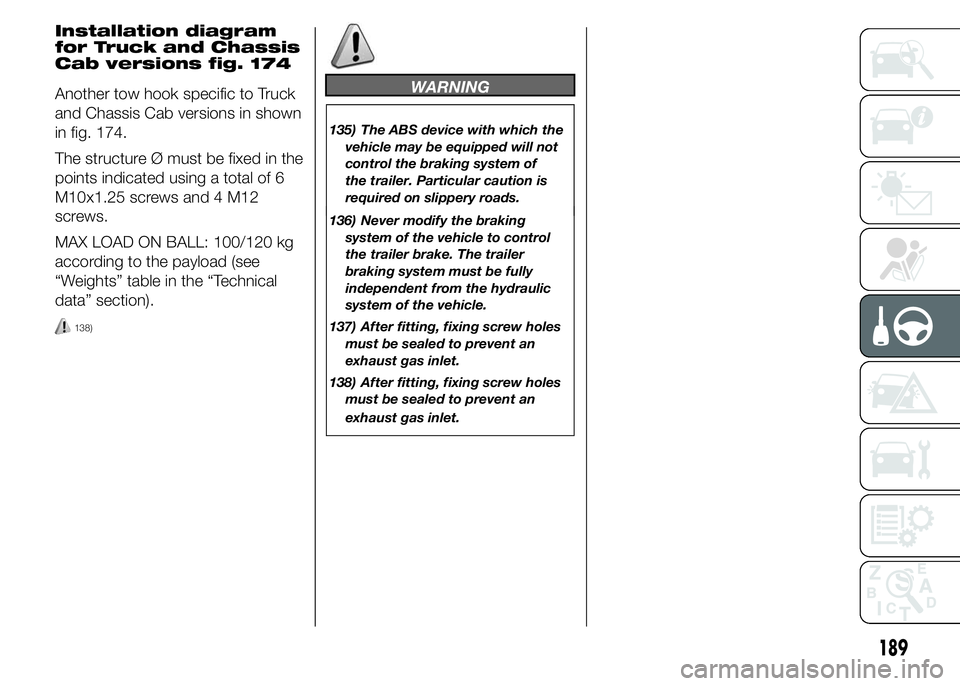
136) Never modify the braking
system of the vehicle to control
the trailer brake. The trailer
braking system must be fully
independent from the hydraulic
system of the vehicle.
137) After fitting, fixing screw holes
must be sealed to prevent an
exhaust gas inlet.
138) After fitting, fixing screw holes
must be sealed to prevent an
exhaust gas inlet.
189
WARNING
135) The ABS device with which the
vehicle may be equipped will not
control the braking system of
the trailer. Particular caution is
required on slippery roads.
Installation diagram
for Truck and Chassis
Cab versions fig. 174
Another tow hook specific to Truck
and Chassis Cab versions in shown
in fig. 174.
The structure Ø must be fixed in the
points indicated using a total of 6
M10x1.25 screws and 4 M12
screws.
MAX LOAD ON BALL: 100/120 kg
according to the payload (see
“Weights” table in the “Technical
data” section).
138)
Page 194 of 367
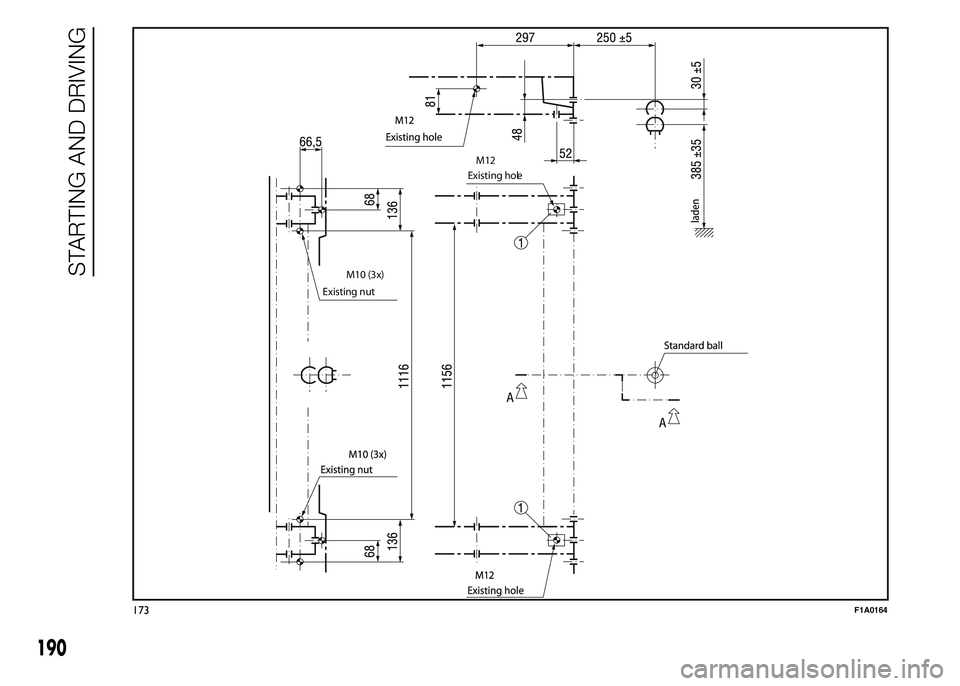
Existing nut
Existing hole
M12
M10 (3x)
173F1A0164
190
STARTING AND DRIVING
Page 195 of 367
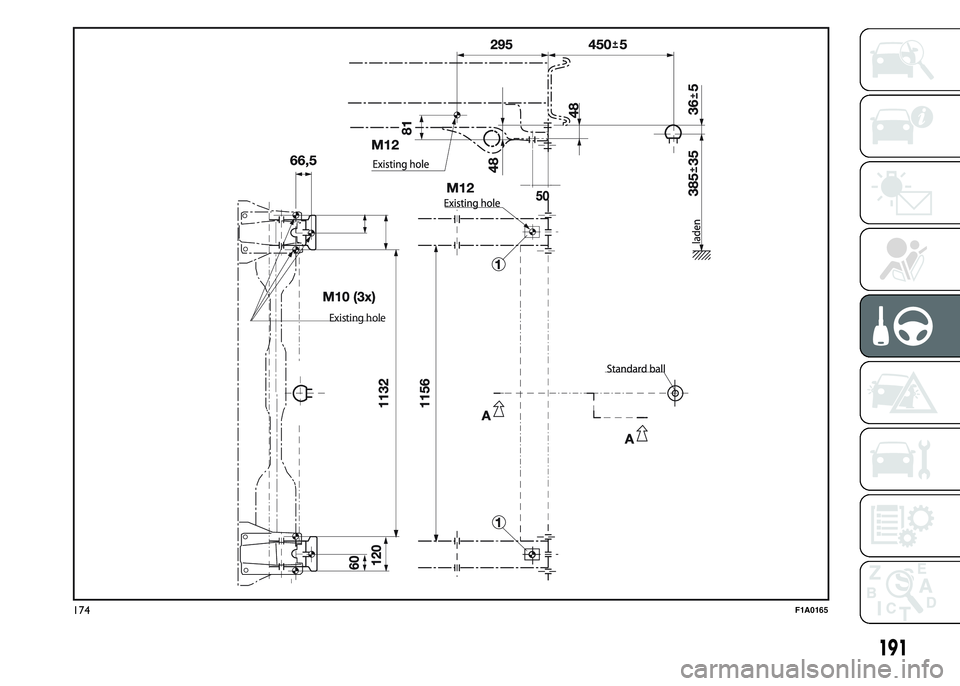
Existing hole
174F1A0165
191
Page 196 of 367
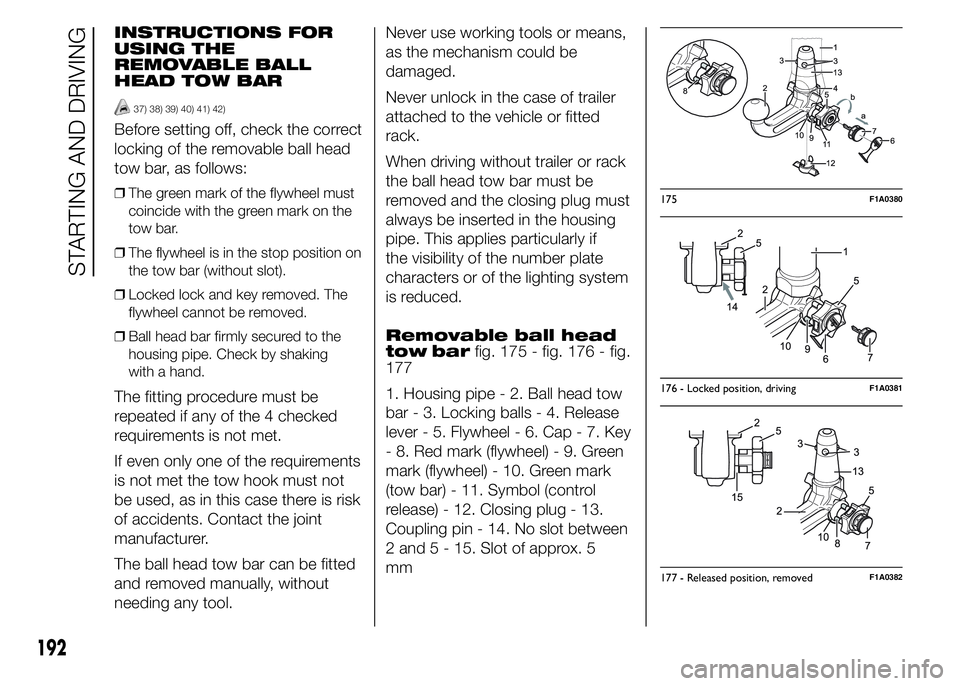
INSTRUCTIONS FOR
USING THE
REMOVABLE BALL
HEAD TOW BAR
37) 38) 39) 40) 41) 42)
Before setting off, check the correct
locking of the removable ball head
tow bar, as follows:
❒The green mark of the flywheel must
coincide with the green mark on the
tow bar.
❒The flywheel is in the stop position on
the tow bar (without slot).
❒Locked lock and key removed. The
flywheel cannot be removed.
❒Ball head bar firmly secured to the
housing pipe. Check by shaking
with a hand.
The fitting procedure must be
repeated if any of the 4 checked
requirements is not met.
If even only one of the requirements
is not met the tow hook must not
be used, as in this case there is risk
of accidents. Contact the joint
manufacturer.
The ball head tow bar can be fitted
and removed manually, without
needing any tool.Never use working tools or means,
as the mechanism could be
damaged.
Never unlock in the case of trailer
attached to the vehicle or fitted
rack.
When driving without trailer or rack
the ball head tow bar must be
removed and the closing plug must
always be inserted in the housing
pipe. This applies particularly if
the visibility of the number plate
characters or of the lighting system
is reduced.
Removable ball head
tow barfig. 175 - fig. 176 - fig.
177
1. Housing pipe - 2. Ball head tow
bar - 3. Locking balls - 4. Release
lever - 5. Flywheel - 6. Cap - 7. Key
- 8. Red mark (flywheel) - 9. Green
mark (flywheel) - 10. Green mark
(tow bar) - 11. Symbol (control
release) - 12. Closing plug - 13.
Coupling pin - 14. No slot between
2 and 5 - 15. Slot of approx. 5
mm
175F1A0380
176 - Locked position, drivingF1A0381
177 - Released position, removedF1A0382
192
STARTING AND DRIVING
Page 197 of 367
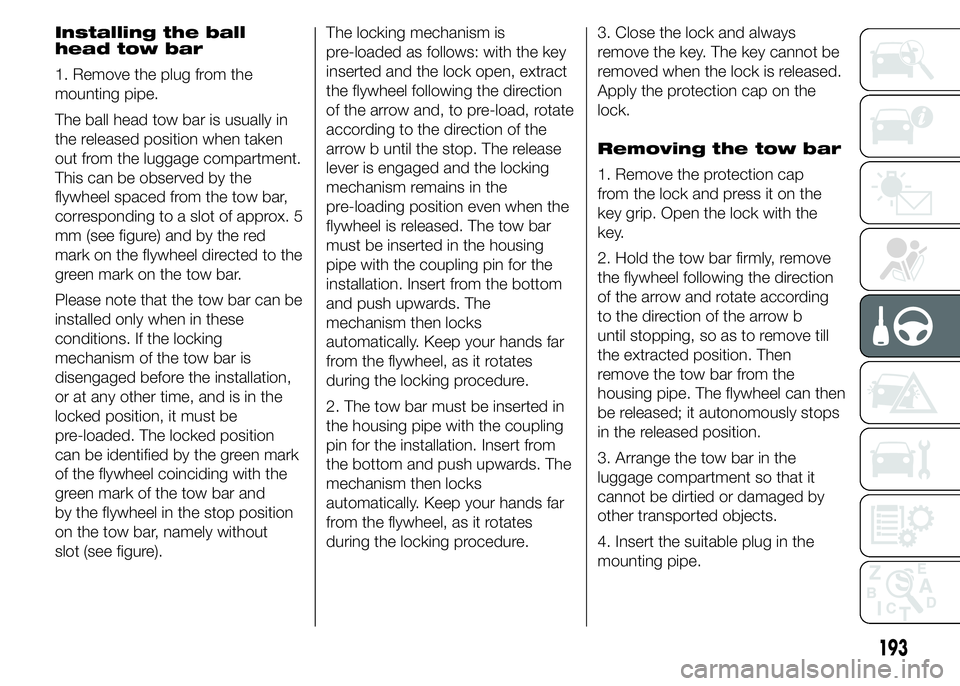
Installing the ball
head tow bar
1. Remove the plug from the
mounting pipe.
The ball head tow bar is usually in
the released position when taken
out from the luggage compartment.
This can be observed by the
flywheel spaced from the tow bar,
corresponding to a slot of approx. 5
mm (see figure) and by the red
mark on the flywheel directed to the
green mark on the tow bar.
Please note that the tow bar can be
installed only when in these
conditions. If the locking
mechanism of the tow bar is
disengaged before the installation,
or at any other time, and is in the
locked position, it must be
pre-loaded. The locked position
can be identified by the green mark
of the flywheel coinciding with the
green mark of the tow bar and
by the flywheel in the stop position
on the tow bar, namely without
slot (see figure).The locking mechanism is
pre-loaded as follows: with the key
inserted and the lock open, extract
the flywheel following the direction
of the arrow and, to pre-load, rotate
according to the direction of the
arrow b until the stop. The release
lever is engaged and the locking
mechanism remains in the
pre-loading position even when the
flywheel is released. The tow bar
must be inserted in the housing
pipe with the coupling pin for the
installation. Insert from the bottom
and push upwards. The
mechanism then locks
automatically. Keep your hands far
from the flywheel, as it rotates
during the locking procedure.
2. The tow bar must be inserted in
the housing pipe with the coupling
pin for the installation. Insert from
the bottom and push upwards. The
mechanism then locks
automatically. Keep your hands far
from the flywheel, as it rotates
during the locking procedure.3. Close the lock and always
remove the key. The key cannot be
removed when the lock is released.
Apply the protection cap on the
lock.
Removing the tow bar
1. Remove the protection cap
from the lock and press it on the
key grip. Open the lock with the
key.
2. Hold the tow bar firmly, remove
the flywheel following the direction
of the arrow and rotate according
to the direction of the arrow b
until stopping, so as to remove till
the extracted position. Then
remove the tow bar from the
housing pipe. The flywheel can then
be released; it autonomously stops
in the released position.
3. Arrange the tow bar in the
luggage compartment so that it
cannot be dirtied or damaged by
other transported objects.
4. Insert the suitable plug in the
mounting pipe.
193
Page 198 of 367
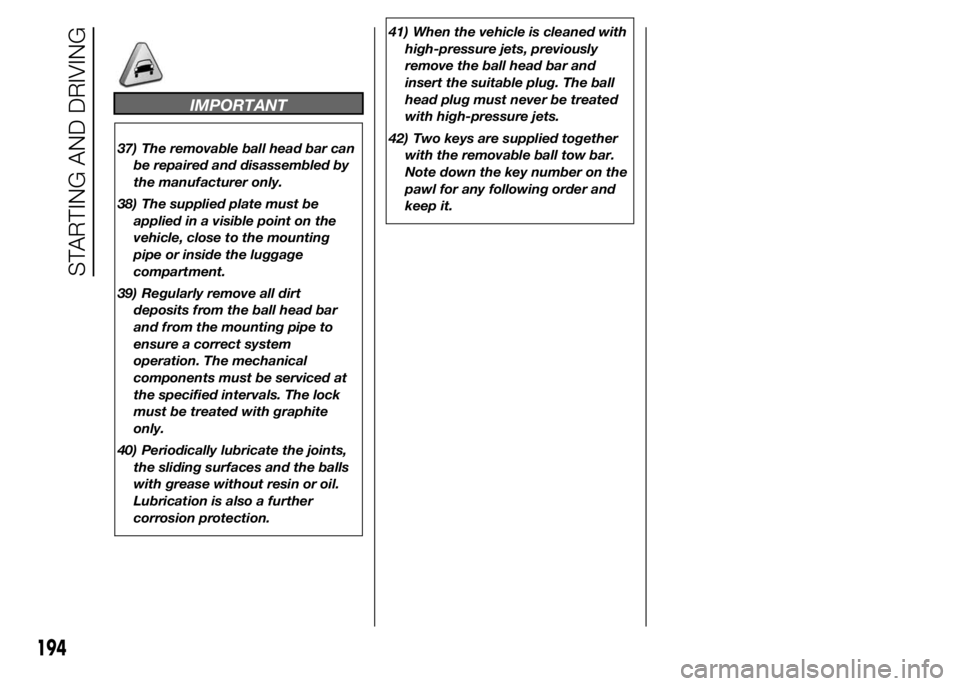
IMPORTANT
37) The removable ball head bar can
be repaired and disassembled by
the manufacturer only.
38) The supplied plate must be
applied in a visible point on the
vehicle, close to the mounting
pipe or inside the luggage
compartment.
39) Regularly remove all dirt
deposits from the ball head bar
and from the mounting pipe to
ensure a correct system
operation. The mechanical
components must be serviced at
the specified intervals. The lock
must be treated with graphite
only.
40) Periodically lubricate the joints,
the sliding surfaces and the balls
with grease without resin or oil.
Lubrication is also a further
corrosion protection.41) When the vehicle is cleaned with
high-pressure jets, previously
remove the ball head bar and
insert the suitable plug. The ball
head plug must never be treated
with high-pressure jets.
42) Two keys are supplied together
with the removable ball tow bar.
Note down the key number on the
pawl for any following order and
keep it.
194
STARTING AND DRIVING
Page 199 of 367
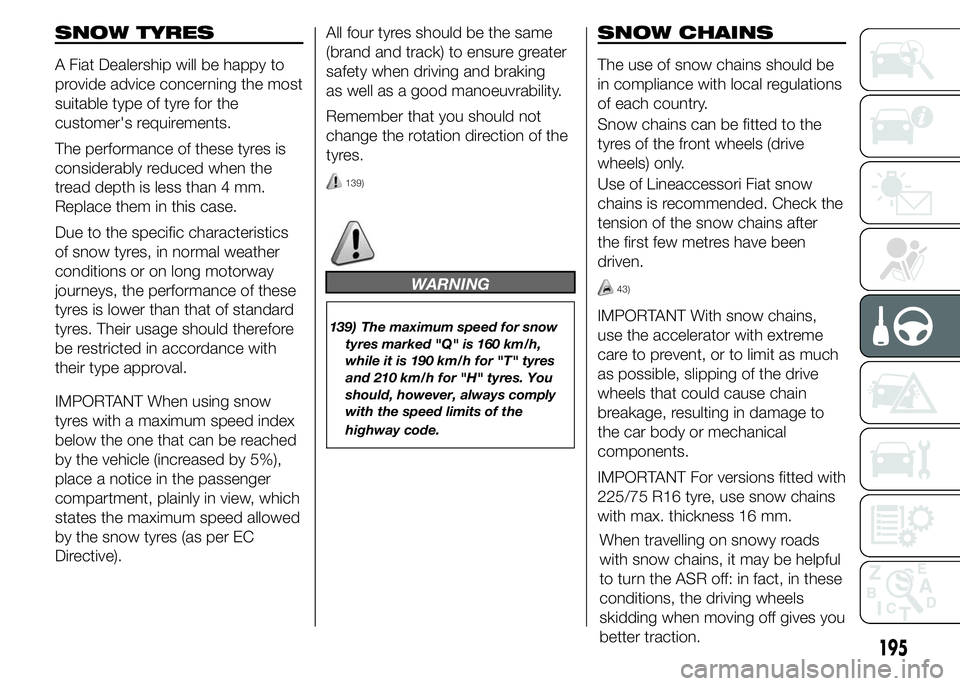
SNOW TYRES
A Fiat Dealership will be happy to
provide advice concerning the most
suitable type of tyre for the
customer's requirements.
The performance of these tyres is
considerably reduced when the
tread depth is less than 4 mm.
Replace them in this case.
Due to the specific characteristics
of snow tyres, in normal weather
conditions or on long motorway
journeys, the performance of these
tyres is lower than that of standard
tyres. Their usage should therefore
be restricted in accordance with
their type approval.
IMPORTANT When using snow
tyres with a maximum speed index
below the one that can be reached
by the vehicle (increased by 5%),
place a notice in the passenger
compartment, plainly in view, which
states the maximum speed allowed
by the snow tyres (as per EC
Directive).All four tyres should be the same
(brand and track) to ensure greater
safety when driving and braking
as well as a good manoeuvrability.
Remember that you should not
change the rotation direction of the
tyres.
139)
WARNING
139) The maximum speed for snow
tyres marked "Q" is 160 km/h,
while it is 190 km/h for "T" tyres
and 210 km/h for "H" tyres. You
should, however, always comply
with the speed limits of the
highway code.
SNOW CHAINS
The use of snow chains should be
in compliance with local regulations
of each country.
Snow chains can be fitted to the
tyres of the front wheels (drive
wheels) only.
Use of Lineaccessori Fiat snow
chains is recommended. Check the
tension of the snow chains after
the first few metres have been
driven.
43)
IMPORTANT With snow chains,
use the accelerator with extreme
care to prevent, or to limit as much
as possible, slipping of the drive
wheels that could cause chain
breakage, resulting in damage to
the car body or mechanical
components.
IMPORTANT For versions fitted with
225/75 R16 tyre, use snow chains
with max. thickness 16 mm.
195
When travelling on snowy roads
with snow chains, it may be helpful
to turn the ASR off: in fact, in these
conditions, the driving wheels
skidding when moving off gives you
better traction.
Page 200 of 367
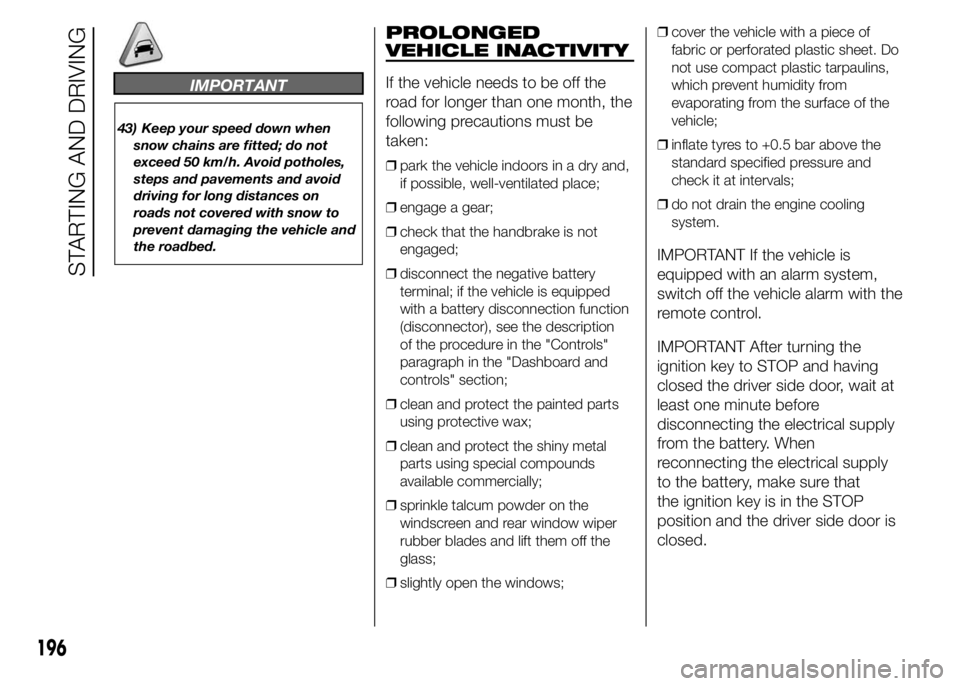
IMPORTANT
43) Keep your speed down when
snow chains are fitted; do not
exceed 50 km/h. Avoid potholes,
steps and pavements and avoid
driving for long distances on
roads not covered with snow to
prevent damaging the vehicle and
the roadbed.
PROLONGED
VEHICLE INACTIVITY
If the vehicle needs to be off the
road for longer than one month, the
following precautions must be
taken:
❒park the vehicle indoors in a dry and,
if possible, well-ventilated place;
❒engage a gear;
❒check that the handbrake is not
engaged;
❒disconnect the negative battery
terminal; if the vehicle is equipped
with a battery disconnection function
(disconnector), see the description
of the procedure in the "Controls"
paragraph in the "Dashboard and
controls" section;
❒clean and protect the painted parts
using protective wax;
❒clean and protect the shiny metal
parts using special compounds
available commercially;
❒sprinkle talcum powder on the
windscreen and rear window wiper
rubber blades and lift them off the
glass;
❒slightly open the windows;❒cover the vehicle with a piece of
fabric or perforated plastic sheet. Do
not use compact plastic tarpaulins,
which prevent humidity from
evaporating from the surface of the
vehicle;
❒inflate tyres to +0.5 bar above the
standard specified pressure and
check it at intervals;
❒do not drain the engine cooling
system.
IMPORTANT If the vehicle is
equipped with an alarm system,
switch off the vehicle alarm with the
remote control.
IMPORTANT After turning the
ignition key to STOP and having
closed the driver side door, wait at
least one minute before
disconnecting the electrical supply
from the battery. When
reconnecting the electrical supply
to the battery, make sure that
the ignition key is in the STOP
position and the driver side door is
closed.
196
STARTING AND DRIVING